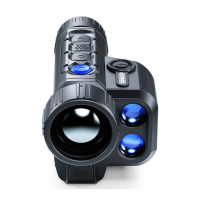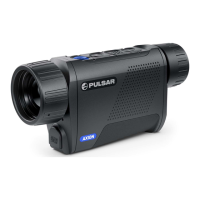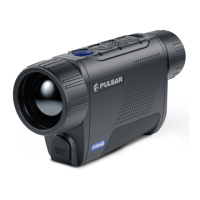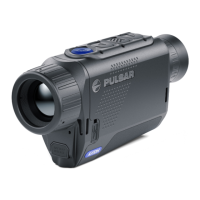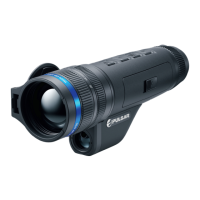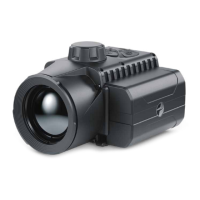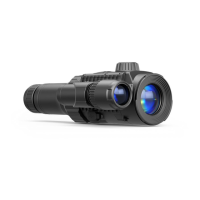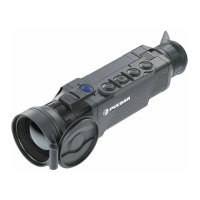9
USER MANUAL FOR AXION THERMAL IMAGING SCOPE
DISPLAY OFF FUNCTION
This function deactivates the image transmission to the display by minimizing its
brightness. This helps prevent accidental disclosure. However, the device stays on.
When this function is in use, the device switches to the standby mode, which allows it to be switched on quickly
if necessary.
•
When the device is on, press and hold the ON (5) button for less than 3 seconds. The display goes blank and
the message Display Off appears.
•
Press the ON (5) button briey to turn on the display.
•
When you press and hold the ON (5) button, the display shows the message Display Off with a countdown.
Holding the button down for the duration of the countdown will power the device off completely.
PIP FUNCTION
The PiP (Picture-in-Picture) function allows you to see both the main image and
a magnied image in a dedicated window.
•
To turn on and off the PiP function see the PiP Mode section in the Main
Menu Functions section of the manual.
•
Press and hold the UP (4) button to change the magnication ratio in the PiP
window.
•
An enlarged image of the central area of the display is shown in an additional window above and the image
area is captured by angles.
•
The main image is displayed with an optical magnication ratio of x1.0.
•
When the PiP is turned on you can control both the discrete and smooth digital zoom. In this case the zoom
value changes only take place in the dedicated window.
•
When the PiP function is turned off, the screen will display at the magnication that was set in PiP mode.
USB CONNECTION
Connecting the device to a computer used as an external power source:
•
Connect one end of the USB cable to the device micro-USB port (9) and the other end to the port on your
computer.
•
Switch the device on with a short press of the ON (5) button.
•
The computer is used as an external power supply. The icon appears
in the status bar. The device will continue operating and all the functions are
available.
•
Note: The battery installed in the device will not be charged.
•
When disconnecting from the computer, the device will continue to operate
from the APS 5 battery if it is present and provided it has enough charge.
TECHNICAL INSPECTION
It is recommended to carry out a technical inspection before each use of the device. Check the following:
•
The device appearance (there should be no cracks on the body).
•
The condition of the lens and eyepiece (there should be no cracks, grease spots, dirt or other deposits).
•
The state of the rechargeable battery (it should be charged) and the electric contacts (there should be no
signs of salts or oxidation).
•
The controls should be in working order.
MAINTENANCE
Maintenance should be carried out at least twice a year and include the following steps:
•
Wipe the exterior metal and plastic surfaces with a cotton cloth to remove dust and dirt. Silicone grease may
be used for this.
•
Clean the electrical contacts of the rechargeable battery on the device using a non-greasy organic solvent.
•
Check the eyepiece and the lens and if required remove dust and dirt from the optics (preferably using a
non-contact method). Cleaning of the exterior surfaces of the optics should only be done with products
specically designed for this purpose.
TROUBLESHOOTING
The table below lists problems that may occur when using the device. Carry out the recommended checks
and troubleshooting steps in the order listed in the table. If there are defects not listed in the table or it is
impossible to resolve the problem yourself, the device should be returned for repair.
Malfunction Possible cause Corrective action
The battery is completely
discharged
The battery is completely
discharged
Charge the battery
The USB cable is damaged The USB cable is damaged Replace the USB cable
The external power supply is
discharged
Charge the external power supply (if necessary)
Calibration is required. Calibration is required. Perform image calibration according to the
Microbolometer Calibration section of the manual
Manual calibration has
been performed with the
lens cover open
Manual calibration has been
performed with the lens cover
open
Check the calibration mode, close the lens cover
and calibrate the device
Brightness or contrast level
is too low
Brightness or contrast level is
too low
Adjust the brightness or contrast
The device was exposed
to static charges during
operation
The device was exposed to static
charges during operation
When the exposure to static charges is over, the
device may either reboot automatically or require
to be switched off and on again
You are looking through
glass
You are looking through glass Remove the glass or change the viewing position
to avoid it
Poor image quality /
reduced detection distance
These problems may occur during observation in adverse weather conditions
(snow, rain, fog, etc.)
When the device is used in
low temperature conditions
the image quality is
worse than in positive
temperatures
In positive temperature conditions, objects being observed (surroundings
and background) heat up differently because of thermal conductivity, thereby
generating a high temperature contrast. Consequently, the image quality produced
by the thermal imager will be better. In low-temperature conditions, objects being
observed (background) will cool down to roughly the same temperature, which
leads to a greatly reduced temperature contrast and a degraded image quality. This
is normal for all thermal imaging devices
Rangender does not
measure distance
In front of the receiver lens
or emitter lens there is an
object that prevents signal
transmission.
Make sure that: the lenses are not blocked by
your hand or ngers; the lenses are clean.
The device vibrates when
measuring
Hold the device level while measuring
Distance to the object exceeds
1000m.
Choose an object at a distance closer than 1000m
Low reection ratio (i.e. leaves
of trees)
Choose an object with a higher reection ratio
Large measurement error Inclement weather conditions (rain, mist, snow)
Repair of the device is possible within 5 years.

